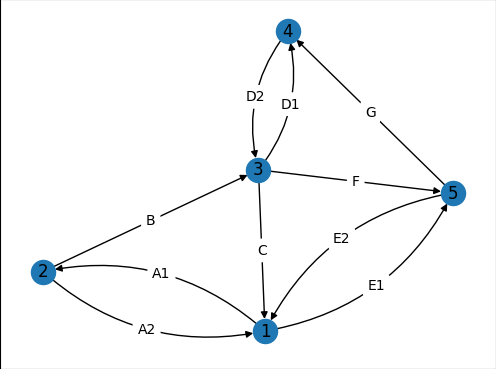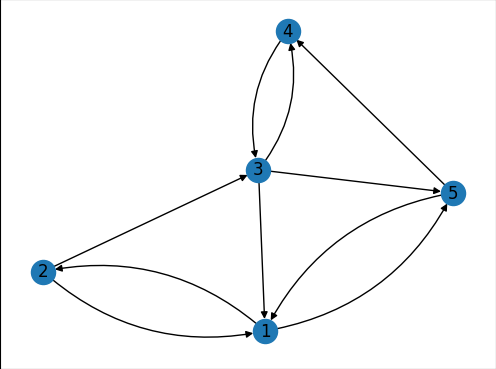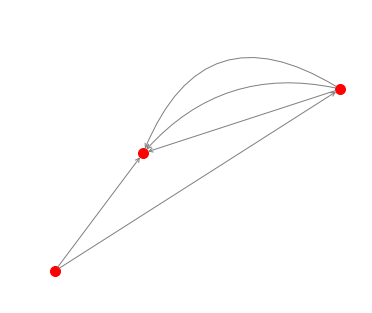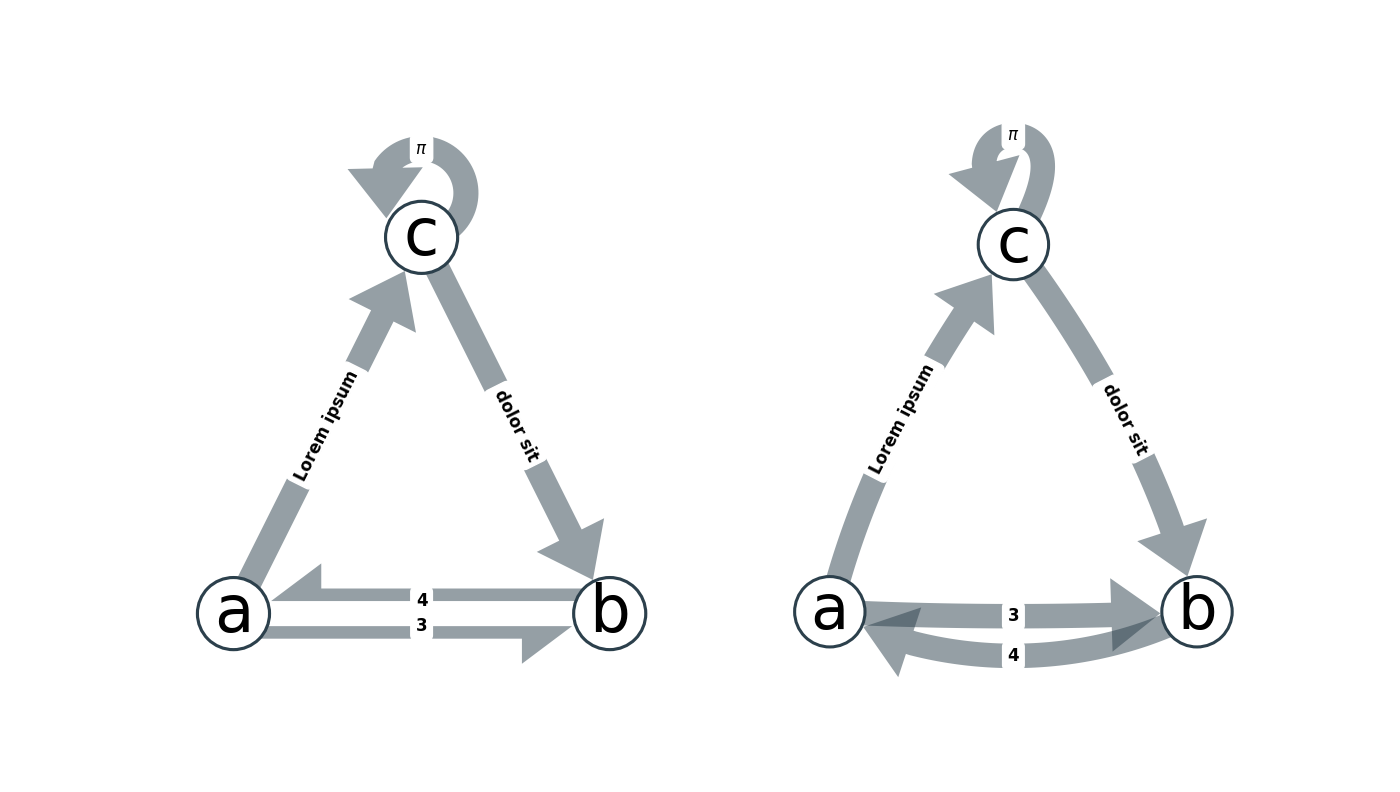Here is how to get an outcome similar to the following:
![Final graph]()
Some properties of this are:
- When there is a single edge between two nodes, it is straight.
- Labels are positioned perfectly in the middle of the edges.
- The current solution works for DiGraphs only. MultiGraphs, MultiDiGraphs, and self loops are not supported.
Setting it up
The following lines are initial code to start the example
import matplotlib.pyplot as plt
import networkx as nx
G = nx.DiGraph()
edge_list = [(1,2,{'w':'A1'}),(2,1,{'w':'A2'}),(2,3,{'w':'B'}),(3,1,{'w':'C'}),
(3,4,{'w':'D1'}),(4,3,{'w':'D2'}),(1,5,{'w':'E1'}),(5,1,{'w':'E2'}),
(3,5,{'w':'F'}),(5,4,{'w':'G'})]
G.add_edges_from(edge_list)
pos=nx.spring_layout(G,seed=5)
fig, ax = plt.subplots()
nx.draw_networkx_nodes(G, pos, ax=ax)
nx.draw_networkx_labels(G, pos, ax=ax)
fig.savefig("1.png", bbox_inches='tight',pad_inches=0)
Which results in:
![Graph with only nodes]()
Drawing edges
The draw_networkx_edges function of NetworkX is able to draw only a subset of the edges with the edgelist parameter. To use this, we group the edges into two lists and draw them separately. Thanks to AMangipinto's answer for connectionstyle='arc3, rad = 0.1'.
curved_edges = [edge for edge in G.edges() if reversed(edge) in G.edges()]
straight_edges = list(set(G.edges()) - set(curved_edges))
nx.draw_networkx_edges(G, pos, ax=ax, edgelist=straight_edges)
arc_rad = 0.25
nx.draw_networkx_edges(G, pos, ax=ax, edgelist=curved_edges, connectionstyle=f'arc3, rad = {arc_rad}')
fig.savefig("2.png", bbox_inches='tight',pad_inches=0)
Which results in:
![Graph without labels]()
Drawing edge labels
The draw_networkx_edge_labels function of NetworkX assumes the edges to be straight and there is no parameter to change this. Since NetworkX is open-souce, I copied the function and created a modified my_draw_networkx_edge_labels. This function is down at the appendix.
Assuming you save this function to a file called my_networkx.py, you can draw edge labels as:
import my_networkx as my_nx
edge_weights = nx.get_edge_attributes(G,'w')
curved_edge_labels = {edge: edge_weights[edge] for edge in curved_edges}
straight_edge_labels = {edge: edge_weights[edge] for edge in straight_edges}
my_nx.my_draw_networkx_edge_labels(G, pos, ax=ax, edge_labels=curved_edge_labels,rotate=False,rad = arc_rad)
nx.draw_networkx_edge_labels(G, pos, ax=ax, edge_labels=straight_edge_labels,rotate=False)
fig.savefig("3.png", bbox_inches='tight',pad_inches=0)
Where we once again seperated curved from straight. The result is the first figure in this answer.
Appendix
The function draw_networkx_edge_labels of NetworkX finds the positions of the labels assuming straight lines:
(x, y) = (
x1 * label_pos + x2 * (1.0 - label_pos),
y1 * label_pos + y2 * (1.0 - label_pos),
)
To find the middle point of a quadratic Bezier curve we can use the following code. First we find the middle control point (ctrl_1 in the code) of the Bezier curve according to the definition in matplotlib:
The curve is created so that the middle control point (C1) is located
at the same distance from the start (C0) and end points(C2) and the
distance of the C1 to the line connecting C0-C2 is rad times the
distance of C0-C2.
Due to this definition, the function my_draw_networkx_edge_labels requires an extra parameter called rad.
pos_1 = ax.transData.transform(np.array(pos[n1]))
pos_2 = ax.transData.transform(np.array(pos[n2]))
linear_mid = 0.5*pos_1 + 0.5*pos_2
d_pos = pos_2 - pos_1
rotation_matrix = np.array([(0,1), (-1,0)])
ctrl_1 = linear_mid + rad*rotation_matrix@d_pos
The functions starting with "ax.transData" are necessary since 90 degree angles in the axis domain do not correspond to 90 degrees in the display. So we had to transform coordinates to and from the display coordinate system.
bezier_mid can be calculated with Bezier curve rules:
ctrl_mid_1 = 0.5*pos_1 + 0.5*ctrl_1
ctrl_mid_2 = 0.5*pos_2 + 0.5*ctrl_1
bezier_mid = 0.5*ctrl_mid_1 + 0.5*ctrl_mid_2
(x, y) = ax.transData.inverted().transform(bezier_mid)
Complete my_draw_networkx_edge_labels:
def my_draw_networkx_edge_labels(
G,
pos,
edge_labels=None,
label_pos=0.5,
font_size=10,
font_color="k",
font_family="sans-serif",
font_weight="normal",
alpha=None,
bbox=None,
horizontalalignment="center",
verticalalignment="center",
ax=None,
rotate=True,
clip_on=True,
rad=0
):
"""Draw edge labels.
Parameters
----------
G : graph
A networkx graph
pos : dictionary
A dictionary with nodes as keys and positions as values.
Positions should be sequences of length 2.
edge_labels : dictionary (default={})
Edge labels in a dictionary of labels keyed by edge two-tuple.
Only labels for the keys in the dictionary are drawn.
label_pos : float (default=0.5)
Position of edge label along edge (0=head, 0.5=center, 1=tail)
font_size : int (default=10)
Font size for text labels
font_color : string (default='k' black)
Font color string
font_weight : string (default='normal')
Font weight
font_family : string (default='sans-serif')
Font family
alpha : float or None (default=None)
The text transparency
bbox : Matplotlib bbox, optional
Specify text box properties (e.g. shape, color etc.) for edge labels.
Default is {boxstyle='round', ec=(1.0, 1.0, 1.0), fc=(1.0, 1.0, 1.0)}.
horizontalalignment : string (default='center')
Horizontal alignment {'center', 'right', 'left'}
verticalalignment : string (default='center')
Vertical alignment {'center', 'top', 'bottom', 'baseline', 'center_baseline'}
ax : Matplotlib Axes object, optional
Draw the graph in the specified Matplotlib axes.
rotate : bool (deafult=True)
Rotate edge labels to lie parallel to edges
clip_on : bool (default=True)
Turn on clipping of edge labels at axis boundaries
Returns
-------
dict
`dict` of labels keyed by edge
Examples
--------
>>> G = nx.dodecahedral_graph()
>>> edge_labels = nx.draw_networkx_edge_labels(G, pos=nx.spring_layout(G))
Also see the NetworkX drawing examples at
https://networkx.org/documentation/latest/auto_examples/index.html
See Also
--------
draw
draw_networkx
draw_networkx_nodes
draw_networkx_edges
draw_networkx_labels
"""
import matplotlib.pyplot as plt
import numpy as np
if ax is None:
ax = plt.gca()
if edge_labels is None:
labels = {(u, v): d for u, v, d in G.edges(data=True)}
else:
labels = edge_labels
text_items = {}
for (n1, n2), label in labels.items():
(x1, y1) = pos[n1]
(x2, y2) = pos[n2]
(x, y) = (
x1 * label_pos + x2 * (1.0 - label_pos),
y1 * label_pos + y2 * (1.0 - label_pos),
)
pos_1 = ax.transData.transform(np.array(pos[n1]))
pos_2 = ax.transData.transform(np.array(pos[n2]))
linear_mid = 0.5*pos_1 + 0.5*pos_2
d_pos = pos_2 - pos_1
rotation_matrix = np.array([(0,1), (-1,0)])
ctrl_1 = linear_mid + rad*rotation_matrix@d_pos
ctrl_mid_1 = 0.5*pos_1 + 0.5*ctrl_1
ctrl_mid_2 = 0.5*pos_2 + 0.5*ctrl_1
bezier_mid = 0.5*ctrl_mid_1 + 0.5*ctrl_mid_2
(x, y) = ax.transData.inverted().transform(bezier_mid)
if rotate:
# in degrees
angle = np.arctan2(y2 - y1, x2 - x1) / (2.0 * np.pi) * 360
# make label orientation "right-side-up"
if angle > 90:
angle -= 180
if angle < -90:
angle += 180
# transform data coordinate angle to screen coordinate angle
xy = np.array((x, y))
trans_angle = ax.transData.transform_angles(
np.array((angle,)), xy.reshape((1, 2))
)[0]
else:
trans_angle = 0.0
# use default box of white with white border
if bbox is None:
bbox = dict(boxstyle="round", ec=(1.0, 1.0, 1.0), fc=(1.0, 1.0, 1.0))
if not isinstance(label, str):
label = str(label) # this makes "1" and 1 labeled the same
t = ax.text(
x,
y,
label,
size=font_size,
color=font_color,
family=font_family,
weight=font_weight,
alpha=alpha,
horizontalalignment=horizontalalignment,
verticalalignment=verticalalignment,
rotation=trans_angle,
transform=ax.transData,
bbox=bbox,
zorder=1,
clip_on=clip_on,
)
text_items[(n1, n2)] = t
ax.tick_params(
axis="both",
which="both",
bottom=False,
left=False,
labelbottom=False,
labelleft=False,
)
return text_items








